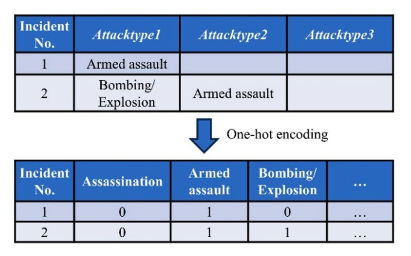Stacking Ensemble Learning with Regression Models for Predicting Damage from Terrorist Attacks
Main Article Content
Abstract
Terrorist attacks can cause unexpectedly enormous damage to lives and property. To prevent and mitigate damage from terrorist activities, governments and related organizations must have suitable measures and efficient tools to cope with terrorist attacks. This work proposed a new method based on stacking ensemble learning and regression for predicting damage from terrorist attacks. First, two-layer stacking classifiers were developed and used to indicate if a terrorist attack can cause deaths, injuries, and property damage. For fatal and injury attacks, regression models were utilized to forecast the number of deaths and injuries, respectively. Consequently, the proposed method can efficiently classify casualty terrorist attacks with an average area under precision-recall curves (AUPR) of 0.958. Furthermore, the stacking model can predict property damage attacks with an average AUPR of 0.910. In comparison with existing methods, the proposed method precisely estimates the number of fatalities and injuries with the lowest mean absolute errors of 1.22 and 2.32 for fatal and injury attacks, respectively. According to the superior performance shown, the stacking ensemble models with regression can be utilized as an efficient tool to support emergency prevention and management of terrorist attacks.
Article Details

This work is licensed under a Creative Commons Attribution-NonCommercial-NoDerivatives 4.0 International License.
References
M. Helbling and D. Meierrieks, “Terrorism and Migration: An Overview,” British Journal of Political Science, vol. 52, no. 2, pp. 977-996, 2022.
G. LaFree and L. Dugan, “Introducing the Global Terrorism Database,” Terrorism and Political Violence, vol. 19, no. 2, pp. 181-204, 2007.
O. A. Olabanjo, B. S. Aribisala, M. Mazzara and A. S. Wusu, “An Ensemble Machine Learning Model for the Prediction of Danger Zones: Towards a Global Counter-Terrorism,” Soft Computing Letters, vol. 3, pp. 1-6, 2021.
M. I. Uddin et al., “Prediction of Future Terrorist Activities Using Deep Neural Networks,” Complexity, vol. 2020, pp. 1-16, 2020.
F. Saidi and Z. Trabelsi, “A Hybrid Deep Learning-Based Framework for Future Terrorist Activities Modeling and Prediction,” Egyptian Informatics Journal, vol. 23, no. 3, pp. 437-446, 2022.
X. Pan and T. Zhang, “Machine Learning-Based Target Prediction for Terrorist Attacks,” Journal of Physics: Conference Series, vol. 2577, no. 1, pp. 1-14, 2023.
P. Agarwal, M. Sharma and S. Chandra, “Comparison of Machine Learning Approaches in the Prediction of Terrorist Attacks,” Proceedings of the 12th International Conference on Contemporary Computing (IC3), pp. 1-7, 2019.
G. R. Ciottone, A. Hart, A. J. Hertelendy and D. Tin, “50 Years of Mass-Fatality Terrorist Attacks: A Retrospective Study of Target Demographics, Modalities, and Injury Patterns to Better Inform Future Counter-Terrorism Medicine Preparedness and Response,” Prehospital and Disaster Medicine, vol. 36, no. 5, pp. 531-535, 2021.
H. Xing, Z. Zhonglin and W. Shaoyu, “The Prediction Model of Earthquake Casualty Based on Robust Wavelet V-SVM,” Natural Hazards, vol. 77, no. 2, pp. 717-732, 2015.
B. Li, A. Gong, T. Zeng, W. Bao, C. Xu and Z. Huang, “A Zoning Earthquake Casualty Prediction Model Based on Machine Learning,” Remote Sensing, vol. 14, no. 1, pp. 1-27, 2022.
S. Sarkar, A. Pramanik, J. Maiti and G. Reniers, “Predicting and Analyzing Injury Severity: A Machine Learning-Based Approach Using Class-Imbalanced Proactive and Reactive Data,” Safety Science, vol. 125, pp. 1-23, 2020.
M. You, S. Li, D. Li and S. Xu, “Applications of Artificial Intelligence for Coal Mine Gas Risk Assessment,” Safety Science, vol. 143, pp. 1-15, 2021.
Y. Feng, D. Wang, Y. Yin, Z. Li and Z. Hu, “An XGBoost-Based Casualty Prediction Method for Terrorist Attacks,” Complex & Intelligent Systems, vol. 6, no. 3, pp. 721-740, 2020.
X. Hu, J. Hu and M. Hou, “A Two-Step Machine Learning Method for Casualty Prediction under Emergencies,” Journal of Safety Science and Resilience, vol. 3, no. 3, pp. 243-251, 2022.
L. Guohui, L. Song, C. Xudong, Y. Hui and Z. Heping, “Study on Correlation Factors that Influence Terrorist Attack Fatalities Using Global Terrorism Database,” Procedia Engineering, vol. 84, pp. 698-707, 2014.
Z. Li, X. Li, C. Dong, F. Guo, F. Zhang and Q. Zhang, “Quantitative Analysis of Global Terrorist Attacks Based on the Global Terrorism Database,” Sustainability, vol. 13, no. 14, pp. 1-19, 2021.
J. Yu, T. Xian, Z.-y. Hu and Y. Liu, “Hazard Grading Model of Terrorist Attack Based on Machine Learning,” International Journal of Advanced Network, Monitoring and Controls, vol. 4, pp. 81-85, 2019.
C.-Y. J. Peng, K. L. Lee and G. M. Ingersoll, “An Introduction to Logistic Regression Analysis and Reporting,” The Journal of Educational Research, vol. 96, no. 1, pp. 3-14, 2002.
T. Cover and P. Hart, “Nearest Neighbor Pattern Classification,” IEEE Transactions on Information Theory, vol. 13, no. 1, pp. 21-27, 1967.
C. Cortes and V. Vapnik, “Support-Vector Networks,” Machine Learning, vol. 20, no. 3, pp. 273-297, 1995.
F. Murtagh, “Multilayer Perceptrons for Classification and Regression,” Neurocomputing, vol. 2, no. 5, pp. 183-197, 1991.
L. Breiman, “Random Forests,” Machine Learning, vol. 45, no. 1, pp. 5-32, 2001.
A. Natekin and A. Knoll, “Gradient Boosting Machines, A Tutorial,” Frontiers in Neurorobotics, vol. 7, pp. 1-21, 2013.
L. Prokhorenkova, G. Gusev, A. Vorobev, A. V. Dorogush and A. Gulin, “CatBoost: Unbiased Boosting with Categorical Features,” Proceedings of the 32nd International Conference on Neural Information Processing Systems, pp. 6639–6649, 2018.
W. Feng, J. Gou, Z. Fan and X. Chen, “An Ensemble Machine Learning Approach for Classification Tasks Using Feature Generation,” Connection Science, vol. 35, no. 1, pp. 1-23, 2023.
A. E. Hoerl and R. W. Kennard, “Ridge Regression: Biased Estimation for Nonorthogonal Problems,” Technometrics, vol. 12, no. 1, pp. 55-67, 1970.
M. Zheng, F. Wang, X. Hu, Y. Miao, H. Cao and M. Tang, “A Method for Analyzing the Performance Impact of Imbalanced Binary Data on Machine Learning Models,” Axioms, vol. 11, no. 11, pp. 1-19, 2022.


